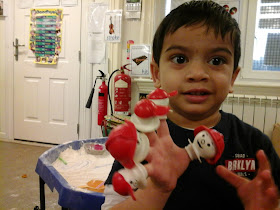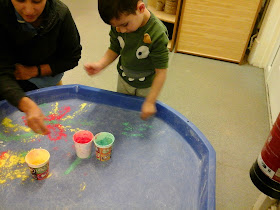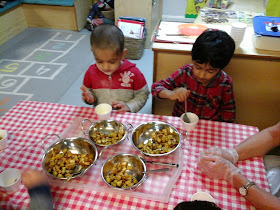Wednesday, 25 October 2017
Role Play
We are promoting children's imaginary play skills in the setting. Being Imaginative is part of the seven areas of learning. To develop children's imaginary skills we provide opportunities for children to take on different roles and practitioners model for them so they copy what the adult does and will eventually continue it when the adult isn't there.
Types of Role PlayRole play, also referred to as imaginative play, is an important activity in most pre-schools, nurseries and schools. Children literally take on roles and act out scenes and characters. You may find that at times this area changes into, for example, a shop, travel agent or garage, so that your child can play a variety of roles. Your child is also likely to have opportunities to play with dolls, farm animals or small figures. These types of toys are sometimes called 'small world toys'. Children play in a slightly different way with this type of equipment. Instead of striding in and being the character themselves, they tend to take on a directing role and move the characters around accordingly. What do children get from this type of play? This type of play has multiple benefits. First, children rehearse, extend and use language in a variety of situations. They may take on the role of the shopper and pretend to count and write a shopping list, as well as ask politely for things. Changing the backdrop of the role play area into, for example, a train station, helps children acquire new vocabulary and expressions in context. Adults may at first play alongside the children to demonstrate the new vocabulary or read a story so that children understand what happens in a shop, train station or newsagent. Learning to co-operate It is in the role play area or lying down with small world equipment where many children learn the skills of co-operation with others. Your child is likely to take turns, agree on what should happen next and learn to negotiate, even if this means the odd amicable squabble. This type of socialisation can really help children to learn about being with others, as there will be some periods of time when adults allow children to play alone and to develop their own world. Gaining confidence Finally, children gain huge amounts of confidence from role play. Confidence is like a magic suit of armour, and the children who are armed with it are usually more willing to try out new activities and able to cope more easily with changes. In terms of role play, confidence is gained by practising necessary skills such as dressing, but it is also gained by organising their own play. This means taking decisions and considering the possible consequences. It may mean that children keep repeating a play event until they are satisfied with it. Being able to make decisions in their play in this way is particularly important for children because in other areas of their lives, it is normally the adults who make the decisions. Role play at home As with many activities that are good for young children, role play does not have to be reserved for nursery or school. You may have already noticed that your child enjoys wearing your shoes or putting on your scarves. This means that you can build on your child's natural desire to 'act and learn' by developing your own range of props at home. These do not have to be 'ready- made' - sometimes simple things such as a pair of shoes, a bag and then a huge cardboard box will set the scene for your child. Be ready to join in yourself, as children often enjoy having an adult playmate whom they can direct. Just don't expect to win any Oscars yet!
Friday, 20 October 2017
Child Lead Tommy Thumb
One of our children has a particular interest in the Tommy Thumb. This week we have incorporated the song into our story time and have been singing about family fingers for our All About Me Topic. This song can easily be adapted to include animals, colours and many other things. Try singing it at home or listening to the song with your children on Youtube.
https://www.youtube.com/watch?v=6dcBprqLw0Q
Tommy Thumb
(“Hands in the air and raise Tommy Thumb”)
Tommy Thumb, Tommy Thumb,
Where are you?
Here I am, here I am,
How do you do?
(“Now it’s Peter Pointer’s turn which is your index finger; he’s the one who points”)
Peter Pointer, Peter Pointer,
Where are you?
Here I am, here I am,
How do you do?
(“Now it's Toby Tall which is your middle finger; he’s the tallest one of them all”)
Toby Tall, Toby Tall,
Where are you?
Here I am, here I am,
How do you do?
(“And now it's Ruby Ring, she’s the fourth one along”)
Ruby Ring, Ruby Ring,
Where are you?
Here I am, here I am,
How do you do?
(“Last, but not least is Baby Small, he’s the littlest finger of all”)
Baby Small, Baby Small,
Where are you?
Here I am, here I am,
How do you do?
(“OK, now for the last time put your fingers in the air, give them a wiggle and wave them everywhere”)
Fingers all, Fingers all,
Where are you?
Here we are, here we are,
How do you do?
Here we are, here we are,
How do you do?
Tommy Thumb, Tommy Thumb,
Where are you?
Here I am, here I am,
How do you do?
(“Now it’s Peter Pointer’s turn which is your index finger; he’s the one who points”)
Peter Pointer, Peter Pointer,
Where are you?
Here I am, here I am,
How do you do?
(“Now it's Toby Tall which is your middle finger; he’s the tallest one of them all”)
Toby Tall, Toby Tall,
Where are you?
Here I am, here I am,
How do you do?
(“And now it's Ruby Ring, she’s the fourth one along”)
Ruby Ring, Ruby Ring,
Where are you?
Here I am, here I am,
How do you do?
(“Last, but not least is Baby Small, he’s the littlest finger of all”)
Baby Small, Baby Small,
Where are you?
Here I am, here I am,
How do you do?
(“OK, now for the last time put your fingers in the air, give them a wiggle and wave them everywhere”)
Fingers all, Fingers all,
Where are you?
Here we are, here we are,
How do you do?
Here we are, here we are,
How do you do?
Gingerbread Decoration Competition
Thank you to everyone who entered our decorate a gingerbread man for Macmillan. All the entries were displayed in nursery. Kim, who was our volunteer last year, came in to judge the entries and chose us a winner. The winner received a Halloween themed gingerbread men decorating set to create at home with his family. Well Done.
Child Lead Bin Collection
One of our children has shown curiosity in the role of a refuse collector. To support this we took the children into the park to pick up rubbish and put it in our small bins. Children also visited the park bins and learnt about where our rubbish should go. On return to nursery our 'Bin Man' emptied all the small bins into his 'Bin Waggon' and took them to the waste site. He also retrieved our nursery bin after it had been emptied.
Child Lead Construction Site
Following one of our children's interests, we enhanced our construction area to create a building site. The children enjoyed playing with the diggers and blocks. They mixed sand and water to make 'cement' and played with natural resources such as leaves and stones.
Celebrating achievements
One of our children who left for school in the summer came back to see us recently with her award she has just received at school. She won her award for doing well with her phonic sounds and letters. A great achievement for her and St Marys @ The Park.
Diwali Celebrations
We had a lovely day learning about the celebration of Diwali yesterday. We carried out a variety of activities linked to the seven areas of learning focusing on People and Communities.
For Wake and Shake we danced with ribbons to Indian music. Children were encouraged to use their wrists, elbows and shoulders to move to the music, promoting muscle development for future writing skills.
For snack time we had spicy rye potatoes. Roxy cooked the delicious dish while the children explored using different tools to cut up boiled potatoes and compare them with some raw ones. Children were encouraged to think about what tool might be the best to use and independently try to cut them up.
At snack time children were encouraged to serve themselves, developing independence.
At story time the children watched and listened to the story of Rama and Sita by diva lamp light. The children each took a diva lamp home.
For Wake and Shake we danced with ribbons to Indian music. Children were encouraged to use their wrists, elbows and shoulders to move to the music, promoting muscle development for future writing skills.
The children created Rangoli patterns outdoors, using powder paints. E.Y.P's talked about the festival of Diwali and the purpose of the Rangoli designs.
Children also practised their mark making skills, choosing their own Rangoli design and mark making implements. Many pre-school children are still holding their mark making tools using a full hand grip. As they develop their hand writing skills they should be beginning to use three fingers to hold writing tools. Please encourage this at home too.
At snack time children were encouraged to serve themselves, developing independence.
At story time the children watched and listened to the story of Rama and Sita by diva lamp light. The children each took a diva lamp home.




































































































